Evidence presented by others that K-feldspar megacrysts in granitoids commonly move as independent crystals and so do not necessarily represent in situ growth includes the following: (1) accumulation, either as (a) abundant, megacryst-rich layers in granites [Vernon 1986; Wiebe 1994, 1996; Healy et al. 2000; Wiebe et al. 2002] or (b) flow-sorted layers ("schlieren") in granites (commonly with graded-bedding and cross-bedding), together with mafic minerals, xenoliths and microgranitoid enclaves [Gilbert 1906; Cloos 1936; Phillips 1968, p. 180; Wilshire 1969, p. 244; Wahrhaftig 1979; Barrière 1981; Vernon 1986, pp. 7-8; Abbott 1989; Reid et al . 1993; Tobisch et al. 1997; Clarke and Clarke 1998; Weinberg et al. 2001]; (2) the common alignment of megacrysts in magmatic structures, as reviewed by Vernon (1986, pp. 5-7); (3) physical incorporation of megacrysts in more mafic magma during magma mixing [Reid et al. 1983; Vernon 1983, 1990, 1991]; and (4) "log jam” accumulations of K-feldspar megacrysts in the narrower parts of channels in magma chambers [Clarke and Clarke 1998; Weinberg et al. 2001].
Evidence that K-feldspar megacrysts in the TB have moved and/or accumulated physically includes the following (also see Gilbert 1906). The processes that we infer to have caused these accumulations will be outlined in the discussion section.
Locally K-feldspar megacrysts cluster in much greater modal proportions than is expected for the composition of the magma (Figure 4a-h).
Imbrication (tiling) of megacrysts is locally preserved (Figure 4b, 4c, 4e, Figure 9d).
Megacrysts may concentrate in dike-like bodies (Figure 5), which in some places intrude other intrusive units with few to no K-feldspar megacrysts (Figure 5c).
Scattered to locally concentrated megacrysts commonly occur in schlieren along channel margins, together with microgranitoid enclaves and xenoliths (Figure 6a-h). In many places, the most aligned K-feldspar megacrysts occur in the more mafic (hornblende-rich) layers (Figure 6a-e, 6h), indicating hydraulic equivalence between megacrysts and hornblende.
Concentrations rich in K-feldspar megacrysts commonly occur in "ladder dikes” or "schlieren tubes" (Figure 7a-d) or in elliptically shaped "plumes” (Figure 8a-d). Some of these plumes consist of up to 80% modal percent of K-feldspar megacrysts (Figure 8a, 8b, 8d), much greater than could possibly occur from direct crystallization of any normal magma composition. Others have concentrations of mafic minerals along their surfaces (Figure 8a, 8b), and still other plumes have distorted overlying schlieren layers (10e), indicating continued movement of megacryst clusters.
Xenoliths (i.e., wall-rock fragments) and microgranitoid enclaves occur in the schlieren troughs, tubes, plumes and other K-feldspar megacryst concentrations (Figure 4d, Figure 8d, 10d,10f), suggesting a connection between the process by which the xenoliths/enclaves were displaced and the associated megacrysts were concentrated.
Megacryst concentrations in the CP phase occur in the megacryst-free outer equigranular HD phase near margins where the two units are juxtaposed (Figure 4h).
Schlieren layers are indented by or drape megacrysts, suggesting differential compaction around existing megacrysts (Figure 9a-c).
Megacrysts that impinge on one another in clusters (Figure 9b, d) locally show truncation of internal zoning, indicative of contact melting (Park & Means 1996), provided that cores with concentric zones are present in both crystals [Vernon et al., 2004]; otherwise, impingement during growth or epitactic nucleation of one crystal on the other are equally plausible interpretations of this relationship [Vernon, 2004; Vernon et al., 2004].
Megacrysts in clusters indent or are wrapped by microgranitoid enclaves, indicating that the megacryst was present and stronger than the enclaves during subsequent strain of the magma (Figure 10d).
K-feldspar megacrysts have been physically incorporated into more mafic magma, as indicated by K-feldspar megacrysts in microgranitoid enclaves or mafic-felsic mingled zones (Figure 4f, 6g, 9b) in TB granitoids [Reid et al. 1983].
K-feldspar megacrysts are locally aligned parallel to the external margin with the host rock, to internal margins between pulses, or parallel to overprinting magmatic foliations (Figure 2, 6, 7) indicating that flow or strain aligned already existing K-feldspar megacrysts.
Figure 5. K-feldspar megacryst accumulations in dike-like bodies
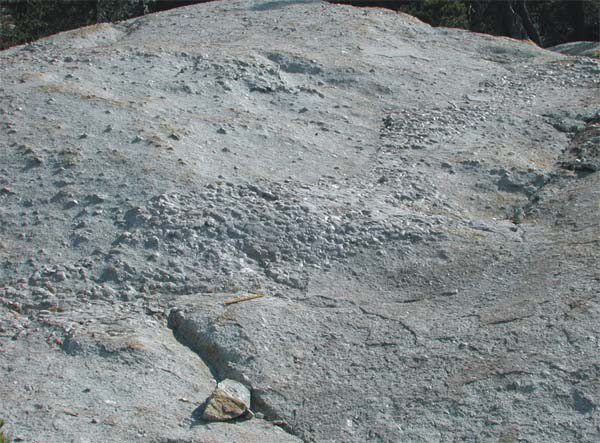
CP 179 (UTM: 0287557 4194677) Elongate (>10 meters by 0.5 to 1 m) megacryst cluster with sinuous and diffuse margins, in CP granodiorite. 15 cm ruler for scale; (View).
SM M 310 (UTM: 0298325 4203484) K-feldspar megacryst-rich dike intruding schlieren-type layering in CP granodiorite, subsequently intruded by a late aplite dike. Some megacrysts are locally tiled, although most occur as independent crystals. 15 cm pencil for scale; (View).
J 162 (UTM: 0291943 4193796) Megacryst-rich dike of CP granodiorite intruding Johnson granite porphyry. The megacrysts decrease near the dike margins, suggesting a possible Bagnold effect. ~36 cm hammer for scale; (View).
SM CP-403 (UTM: 0298525 4203748) megacryst-rich dike of CP granodiorite cutting a metavolcanic raft along eastern margin of batholith, with weak alignment of megacrysts parallel to dike walls. Small veins of CP phase with few or no megacrysts extend out from dike. 36 cm hammer for scale. (View).
Figure 6. K-feldspar megacryst accumulation in troughs
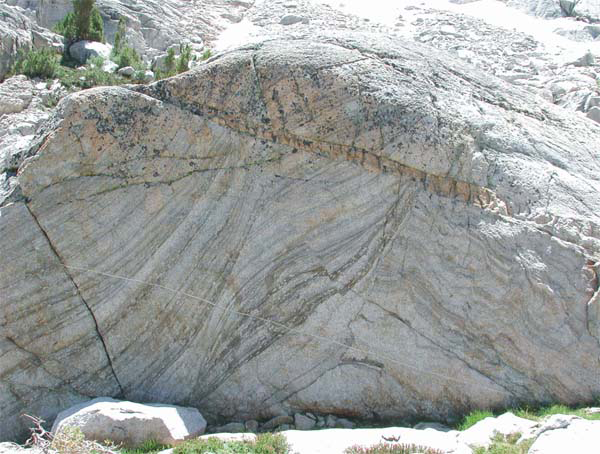
SM M Z-329 ( UTM: 0298300; 4203320) Three sets of cross-cutting schlieren troughs with trough axes plunging gently (~12 o ) away from viewer. Late aplite dike cuts all three sets. Oldest set to right is folded and deflected (along with middle set) by diapiric rise of K-feldspar megacryst-rich layer at base of cliff face. Middle trough set offset by magmatic fault (see next photo). this fault does not offset youngest set, nor the CP diapir at base of cliff. All three sets show strongly aligned megacrysts in mafic (hornblende and biotite) layers and decreasing alignment away from these layers (e.g. base of the troughs). Cliff face about 7 m high; (View).
SM MZ-329 (UTM: 0298300; 4203320 ) Close-up of middle schlieren trough set shown in Photo A. Well aligned megacrysts in mafic schlieren; magmatic fault offsets the schlieren locally truncates the megacrysts. Megacryst-rich CP phase at base. 15 cm ruler for scale; (View).
CP 292 (UTM: 0297209 4205369) Aligned and unaligned K-feldspar megacrysts in schlieren trough. Axis of trough nearly vertical; so layering dips steeply. See Fig. 6D for close-up. 15 cm ruler for scale; (View).
CP-292 (UTM: 0297209 4205369) Close-up of megacrysts in schlieren in Fig. 6C. 15 cm ruler for scale; (View).
CP-Z-256 ( UTM: 0298326; 4204274) Schlieren at the base of troughs with strongly aligned K-feldspar megacrysts. Trough cut-offs and grading of mafic minerals both indicate younging to left. Megacryst alignment decreases away from base of troughs. ~25 cm hammer for scale; (View).
CP-167 (UTM: 0289838 4194967) Faint schliere marks internal margin, with megacryst accumulation immediately above schliere. 15 cm ruler for scale; (View).
SM-HD 335 (UTM: 0298191 4203473) Base of trough where both K-feldspar megacrysts and large euhedral hornblende crystals have accumulated. 15 cm ruler for scale; (View).
CP Z-255 ( UTM: 0298401; 4204132 ) Large schlieren troughs locally cut by magmatic faults (immediately to left of person) and intruded by slightly younger CP phase. aligned megacrysts in schlieren presumably were present before magmatic faulting and reintrusion by CP granodiorite. (View).
Figure 7. K-feldspar megacrysts in tubes
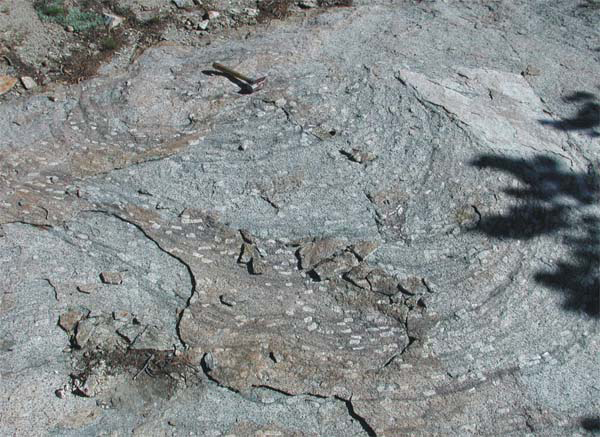
Tubes differ from troughs by having the boundary-parallel schlieren entirely enclosed (thus forming elliptical patterns) in sections perpendicular to the tube axis; tube axes in the TB almost always plunge at angles greater than 70 o:
SM M 352 (UTM: 0298485 4203607). Large schlieren tube in hybrid HD phase with aligned megacrysts in the schlieren. Tube axis near vertical. ~36 cm hammer for scale.; (View).
CP 167 (UTM: 0289838 4194967) Subhorizontal and steeply dipping surfaces through a schlieren tube. Megacrysts are aligned in both schlieren in the approximately vertical "feeder pipe” and schlieren forming elliptical sections in the subhorizontal plane. Megacrysts are also concentrated in the center of the tube (subhorizontal face). 15 cm ruler for scale; (View).
CP-291 (UTM: 0297095 4205422) Subhorizontal and steeply dipping surfaces through a steeply plunging schlieren tube. Megacrysts occur only in the center of the tube. 31 cm map case for scale.; (View).
CP 535 (UTM: 0288450 5197268) Horizontal cut through steeply plunging, migrating schlieren tube, the "snail structure” of Weinberg et al. (2001) The largest crystal faces of K-feldspar megacrysts are aligned parallel to schlieren, but long axes of megacrysts show some variation in orientation. 15 cm ruler for scale. (View).
Figure 8. K-feldspar megacrysts in plumes
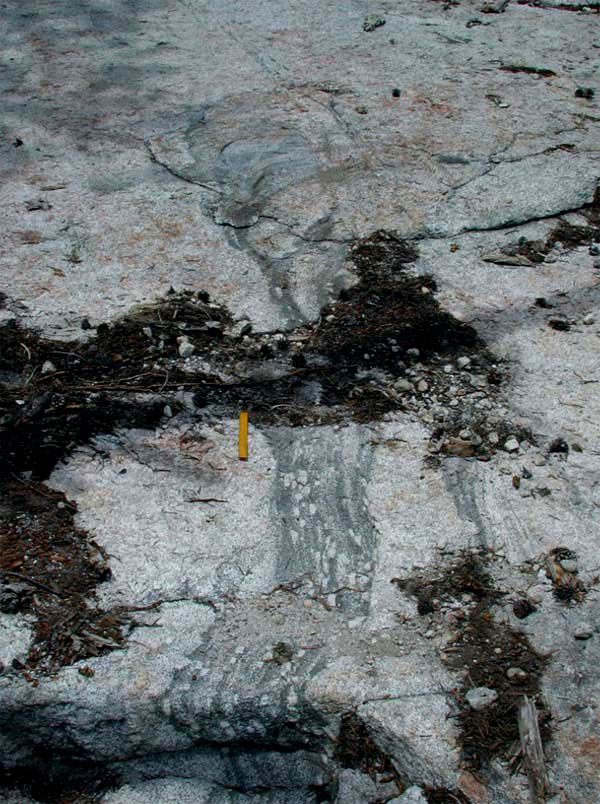
Plumes are relatively homogeneous columns with fewer or no schlieren layers, and also almost always have steeply plunging axes in the TB:
CP167 (UTM: 0289838 4194967) Concentration of megacrysts in sharply bound plume known as "The Mummy.” Mafic minerals are concentrated along side and upper margin of plume. 36 cm hammer for scale.; (View).
CP 649 (UTM: 0288577 4197802) Vertical and subhorizontal (top and bottom of photo) surfaces through a vertically plunging megacryst-rich plume. In subhorizontal surfaces, plume forms elliptical pattern. A small amount of enrichment in mafic minerals occurs along the plume margins. Megacrysts show weak alignment in a subhorizontal direction, as though vertical compaction had o ccurred in the plume. 36 cm hammer for scale.; (View).
SM CP 349 (UTM: 0298488 4203738) Small schlieren tubes and troughs along margin of large (~15 m diameter) vertically plunging megacryst-rich plume (lower right corner of photo). These secondary tubes and troughs occur elsewhere along the margin of this plume suggesting a genetic relationship. 36 cm hammer for scale; (View).
SM CP 349 (UTM: 0298488 4203738) Close-up of K-feldspar megacryst-rich plume in lower-right corner of area shown in Fig. 7g. forming 80% of rock. Small xenoliths of host rock are also present. One interpretation is that the megacryst accumulation (plus accompanying volatiles?) was more buoyant and thus drove upward motion in tube, thereby supporting the xenoliths. Even with this high percentage of megacrysts , molding relationships are rare to absent. 15 cm ruler for scale. (View).
Figure 9. Compaction around K-feldspar megacrysts
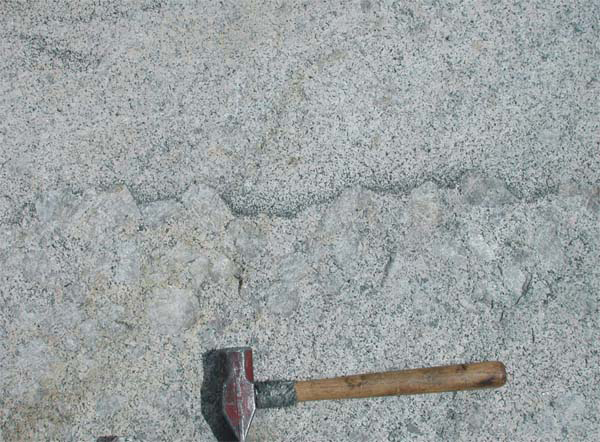
CP 292 (UTM: 0297209 4205369) Schlieren layer indented by o r draping megacrysts. Mafic layer thins and disappears at points of greatest deflection (upper corners of some megacrysts). 36 cm hammer for scale; (View).
CP-Z-294 ( UTM: 0297260;4207191) Deflection of schlieren by K-feldspar megacrysts. Rare truncated corners (e.g., arrows) where megacrysts touch may result in contact melting. ~5 cm camera lens for scale; (View).
CP 805 (UTM: 0281704 4210788) Subhorizontal alignment of K-feldspar megacrysts in a vertical plume. 15 cm ruler for scale; (d) (UTM: not available) Megacryst cluster , in which some megacrysts in contact may have undergone contact melting (arrows). Inclusions are aligned parallel to crystal faces of some megacrysts. Late quartz-filled fractures also present. 15 cm ruler for scale. (View).